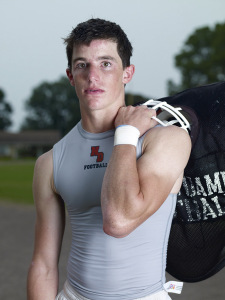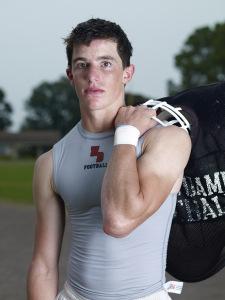When I first encountered Catherine Opie’s photographs some time ago, I was delighted and intrigued by her work; her attention to detail, sensitivity toward color and composition, and fearless documentation of queer subcultures left an impression on me as an artist and thinker.
And so it was with equal delight, if not perhaps slight confusion, that I came face to face with her football series for the first time (on view in Catherine Opie: Figure and Landscape). For Opie, these photographs were a more traditional approach to photography in subject matter and style: crisp and colorful photographs of an American tradition. But, as I soon realized, there was far more to these photographs beyond their initial aesthetic viewing pleasure. As these photographs continued to grow on me, I realized that Opie’s portraits of high school footballers became, in part, a critique of the way in which our culture constructs masculinity.

Catherine Opie, “Tyler,” 2007, Hammer Museum, Los Angeles, purchase.
The subjects of these portraits are not men, nor are they boys; they are teenagers in transition, and it is with acne, braces, and a youthful awkwardness that they come to inhabit the hyper-masculinized footballer’s uniform and identity. They do not quite fit into their roles as footballers, or as men, but it is clear that they have made a choice about where they stand. Or has this choice been made for them? The portraits possess a quiet dignity as well as an underlying critique of that very dignity with which these teenagers hold themselves.
Henry William Crouch, Intern, Wallis Annenberg Photography Department



